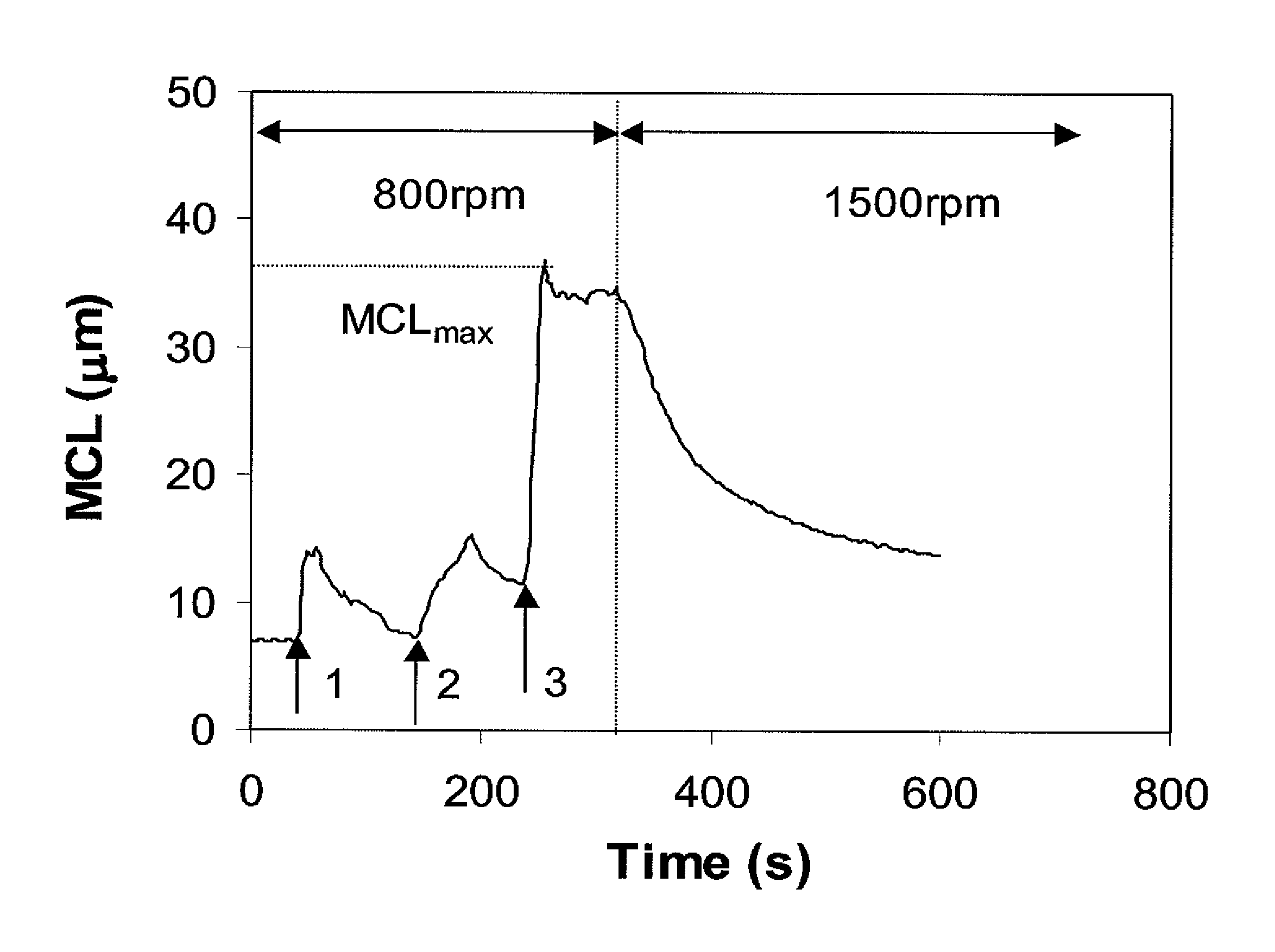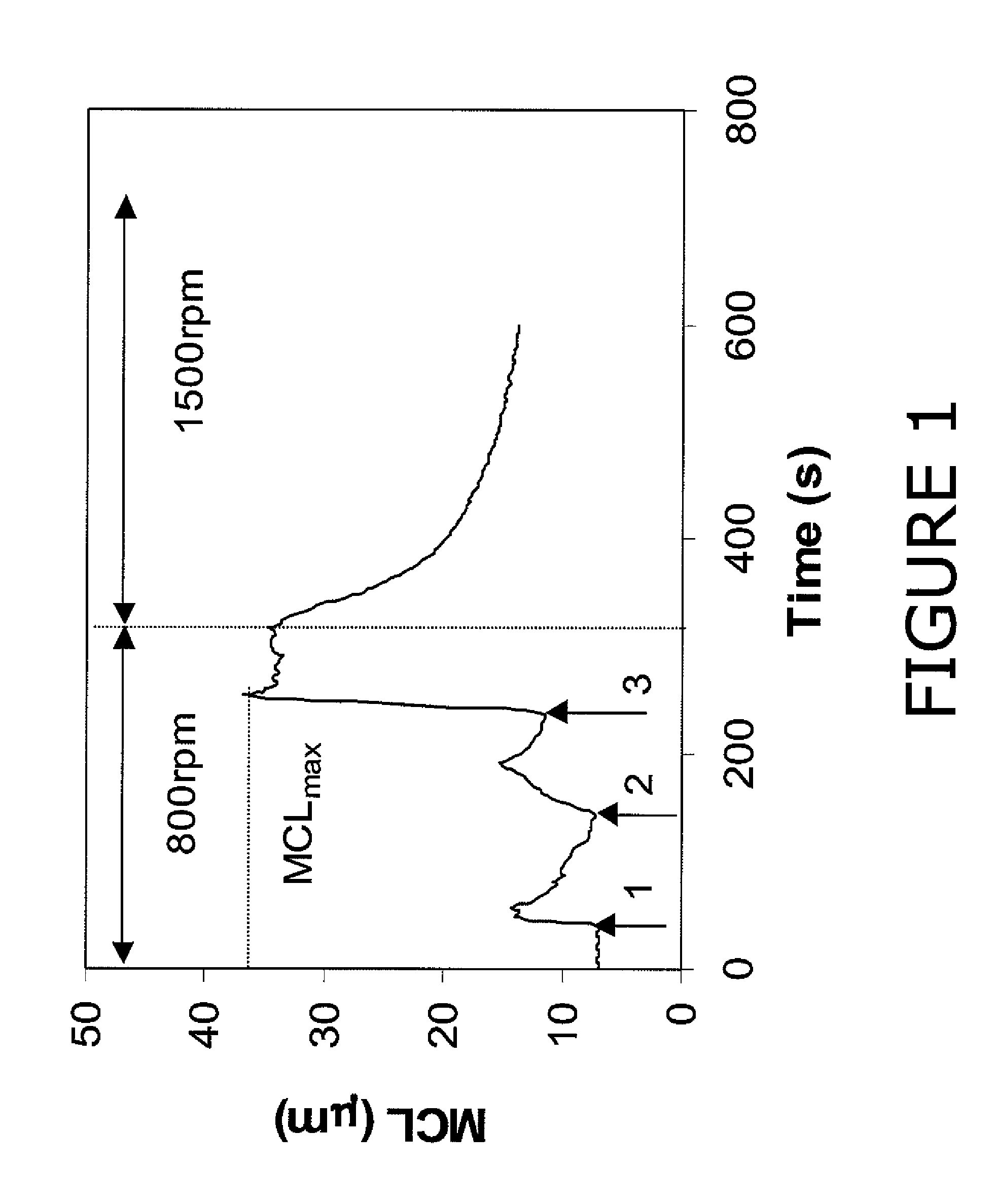Controllable filler prefloculation using a dual polymer system
a dual-polymer system and filler technology, applied in papermaking, non-fibrous pulp addition, reinforcing agent addition, etc., can solve the problems of filler flocs, reduced finish strength, and increased difficulty in maintaining an even distribution of fillers across the three-dimensional sheet structur
- Summary
- Abstract
- Description
- Claims
- Application Information
AI Technical Summary
Benefits of technology
Problems solved by technology
Method used
Image
Examples
examples 1-7
[0071]The filler used for each example was either undispersed or dispersed, scalenohedral PCC (available as Albacar HO from Specialty Minerals Inc., Bethlehem, Pa. USA). When undispersed PCC is used, the dry product was diluted to 10% solids using tap water. When dispersed PCC was used, it was obtained as 40% solids slurry and is diluted to 10% solids using tap water. The size distribution of the PCC was measured at three second intervals during flocculation using a Lasentec® S400 FBRM (Focused Beam Reflectance Measurement) probe, manufactured by Lasentec, Redmond, Wash. A description of the theory behind the operation of the FBRM can be found in U.S. Pat. No. 4,871,251. The mean chord length (MCL) of the PCC flocs is used as an overall measure of the extent of flocculation. The laser probe is inserted in a 600 mL beaker containing 300 mL of the 10% PCC slurry. The solution is stirred using an IKA RE16 stirring motor at 800 rpm for at least 30 seconds prior to the addition of floccu...
example 8
[0078]This experiment demonstrates the feasibility of using a continuous process to flocculate the PCC slurry. A batch of 18 liters of 10% solids undispersed PCC (available as Albacar HO from Specialty Minerals Inc., Bethlehem, Pa. USA) in tap water was pumped using a centrifugal pump at 7.6 L / min into a five gallon bucket. A 1.0 lb / ton active dose of 0.3% solids flocculant A solution was fed into the PCC slurry at the centrifugal pump inlet using a progressive cavity pump. The PCC was then fed into a static mixer together with 1.0 lb / ton active dose of a 0.7% solids solution of coagulant A. The size distribution of the filler flocs was measured using the Mastersizer Micro and reported in Table II. 300 mL of the resultant slurry was stirred in a beaker at 1500 rpm for 8 minutes in the same manner as in Examples 1-7. The characteristics of the filler flocs at 4 minutes and 8 minutes are listed in Tables III and IV, respectively.
example 9
[0079]The filler slurry and experimental procedure was the same as in Example 8, except that coagulant A was fed into the centrifugal pump and flocculant A was fed into the static mixer. The size characteristics of the filler flocs are listed in Tables II, III and IV.
[0080]
TABLE IPCC type, flocculating agent descriptions, and flocculatingagent doses for examples 1 through 9.Polymer 1Polymer 2MicroparticleDoseDoseDoseExPCC TypeName(lb / ton)Name(lb / ton)Name(lb / ton)1UndispersedStalok 40020NoneNone2UndispersedFlocculant A1Coagulant A1None3UndispersedCoagulant A1Flocculant A1None4UndispersedFlocculant B1Coagulant B3B25UndispersedCoagulant B3Flocculant B1B26DispersedFlocculant A1.5Coagulant A4None7DispersedCoagulant A1Flocculant A1.5None8UndispersedFlocculant A1Coagulant A1None9UndispersedCoagulant A1Flocculant A1NoneStalok 400 Cationic starch available from Tate & Lyle, Decatur, IL USAFlocculant A Anionic sodium acrylate-acrylamide copolymer flocculant with an RSV of about 32 dL / g and a c...
PUM
| Property | Measurement | Unit |
|---|---|---|
| median particle size | aaaaa | aaaaa |
| diameter | aaaaa | aaaaa |
| concentration | aaaaa | aaaaa |
Abstract
Description
Claims
Application Information
 Login to View More
Login to View More - R&D
- Intellectual Property
- Life Sciences
- Materials
- Tech Scout
- Unparalleled Data Quality
- Higher Quality Content
- 60% Fewer Hallucinations
Browse by: Latest US Patents, China's latest patents, Technical Efficacy Thesaurus, Application Domain, Technology Topic, Popular Technical Reports.
© 2025 PatSnap. All rights reserved.Legal|Privacy policy|Modern Slavery Act Transparency Statement|Sitemap|About US| Contact US: help@patsnap.com



